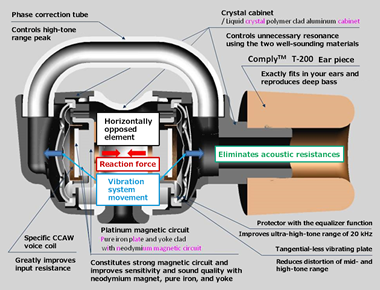- HOME »
- Our technology
Our technology
Mechanism to hear the sound
Sound is affected by ear canal until it reaches the eardrum.
The length of the ear canal is generally referred to as 25 to 30 mm as shown in Figure 1.
One side of an ear canal is closed by eardrum, so air column resonance occurs at λ /4 and 3λ/4 (open-tube resonance).
Figure 2 shows the acoustic pressure-frequency characteristics at eardrum when the 25-30 mm open tube resonates. The acoustic pressure rises at around 3 kHz and 10 kHz due to resonance.
* In fact the effects of auricle and head reflection and diffraction, etc. show more complicated characteristics, but it is omitted here for simplification.
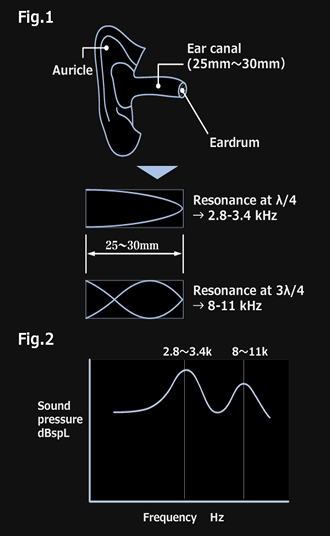
When putting on a canal-type headphones
An ear canal is closed when the canal-type headphone is put on your ear as shown in Figure 3.
The both sides of the ear canal are closed, and thus the mode of resonance will be changed. That is, air column resonance occurs at λ /2 and λ (closed-tube resonance).
Figure 4 shows the acoustic pressure-frequency characteristics at eardrum when the 25-30 mm closed-tube resonates. The acoustic pressure rises at around 6 kHz and 12 kHz due to resonance.
This resonance occurred at 6 kHz causes keen high-pitched sound, especially the s sound (sa, shi, su, se, so) that might disturb cozy listening to music. Also, sound with higher frequency than this resonance will be hard to hear due to the masking effect.
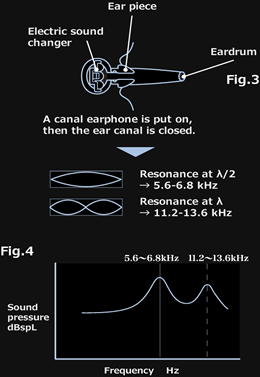
Handling by conventional technologies
To suppress the resonance of 6kHz;
Set acoustic resistances in series on the sound propagation path of the canal-type headphones as shown in Figure 5. Higher frequency is more likely to attenuate due to the effect of acoustic resistance as shown in Figure 6 (acoustic pressure-frequency characteristics). Although the resonance at around 6 kHz can be suppressed, the 10 or more kHz range necessary for playing music will also greatly attenuate, so balancing is needed to some extent.
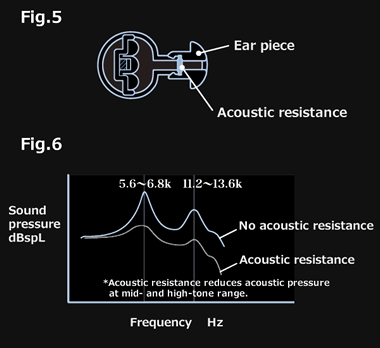
Figure 8 shows the bypass made for canal headphone sound propagation path.
To suppress the resonance of 6kHz:
Sound waves with the identical phases at the bypass starting point P will be delayed in phase at point Q.
To delay phases 180 degrees at the intended 6kHz:
λ=V/f (λ: wavelength of sound wave, V: sound velocity, f: frequency), where the sound velocity is 340 m/s and the frequency is 6 kHz. λ=340/6000=0.0566 m=5.66 cm. Therefore, half wavelength is 2.84 cm (approx. 28 mm).
If the length of the bypass is set to approximately 28 mm, the sound propagating straight-forward and the bypassing one will have opposite phases and be cancelled out each other at around 6 kHz as shown in Figure 8b.
The dashed line in Figure 9 shows the characteristics of acoustic pressure and frequency in headphones with bypass. The figure also shows that the peak at around 6 kHz is suppressed and acoustic pressure of 10 kHz or more high-tone range will not so greatly lowered.
At the same time, the masking effects in high-tone range are resolved and feeble sound can be heard.
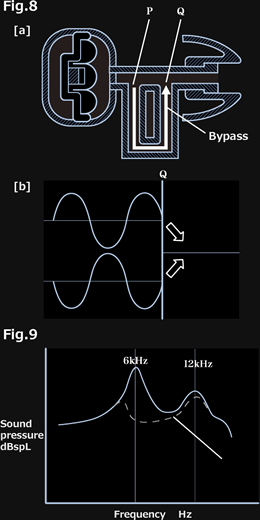
Tornado Equalizer Technology Patent No. 4681698
Birth of Tornado Equalizer
While I was considering how to make a difference between sound propagation paths of a canal headphone, an idea of applying twist came to my mind when I saw the phoenix honey orchid dancong tea (Chinese tea). Technically, to make sound propagation paths with a difference of approximately 28 mm in length in a canal headphone, hollow screw-like parts are attached as shown in Figure 10.
The difference of sound propagation paths are made by two routes; first route that runs through the center of the pipe and second route that runs helically though the aperture between the root of thread and the external wall.
The sound wave in the external route propagates like tornado, so I named this product the Tornado Equalizer. The logo of the Tornado Equalizer comes from the design of sound wave propagation.
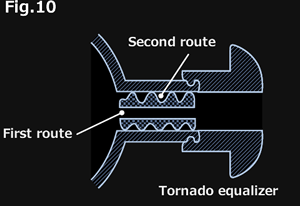
Twin equalized Element System Patent No. 4953490
Twin equalized element system
The following four major effects can be achieved in the twin-equalized element system:
1st effect
The opposed element placement cancels mechanical vibration due to reaction of vibration system and realizes deeper bass tones than that of conventional closed types.
2nd effect
The parallel drive of twin element enhances sound pressure sensitivity in low- and mid-range tones.
3rd effect
The phase correction tube suppresses closed ear canal resonance, eliminates the masking effects, and dramatically improves sounding in mid- and high-tone range.
4th effect
Eliminates acoustic resistances. The small element dramatically improves ultra-high-tone range and realizes the spread of sound like open-air types.
*click for full size
A.I.R.system Acoustic Internal-pressure Regulator system Patented
Sound deterioration factors of air-tight Dynamic type earphones:
Highly air-tight front and/or rear cavity in Dynamic type earphones could reduce sound leakage but pressure occurs on diaphragm will increase the lowest resonance frequency; thus reducing lower bass sound range.
High air-tight level will also increases unwanted internal reverberations which obstruct sound spatial impression.
A.I.R system front & rear pressure regulator:
Front and rear cavities are connected by acoustic factors; Ma, Ra.
This connectivity reduces rear cavity air pressure, resulting;
a) Prevent increase of lowest resonance frequency; thus deep bass sounds are secured.
b) Prevent increase of unwanted internal reverberations.
A.I.R system cavities pressure exhaust:
1st rear cavity; Cb; and 2nd rear cavity; Cc; are connected by narrow tube; Mb.
And narrow passage; Mc; connects the 2nd rear cavity; Cc; to outside.
This carefully designed dual high-cut filter; controlled air passage and air discharge of Cb+Md and Cc+Mc; significantly prevents high frequency sound leakage from inside to outside and controls necessary lower bass sound range.
This dual high-cut filter also significantly prevents noise entering from outside to inside.
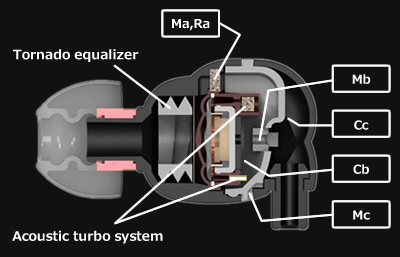
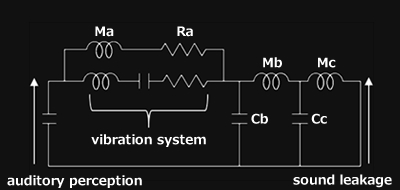
The new“Tornado Turbo Air system”; combination of A.I.R system, Tornado equalizer and Acoustic turbo system; successfully achieved the spatial sound expression of open air type and yet high sound insulation.
